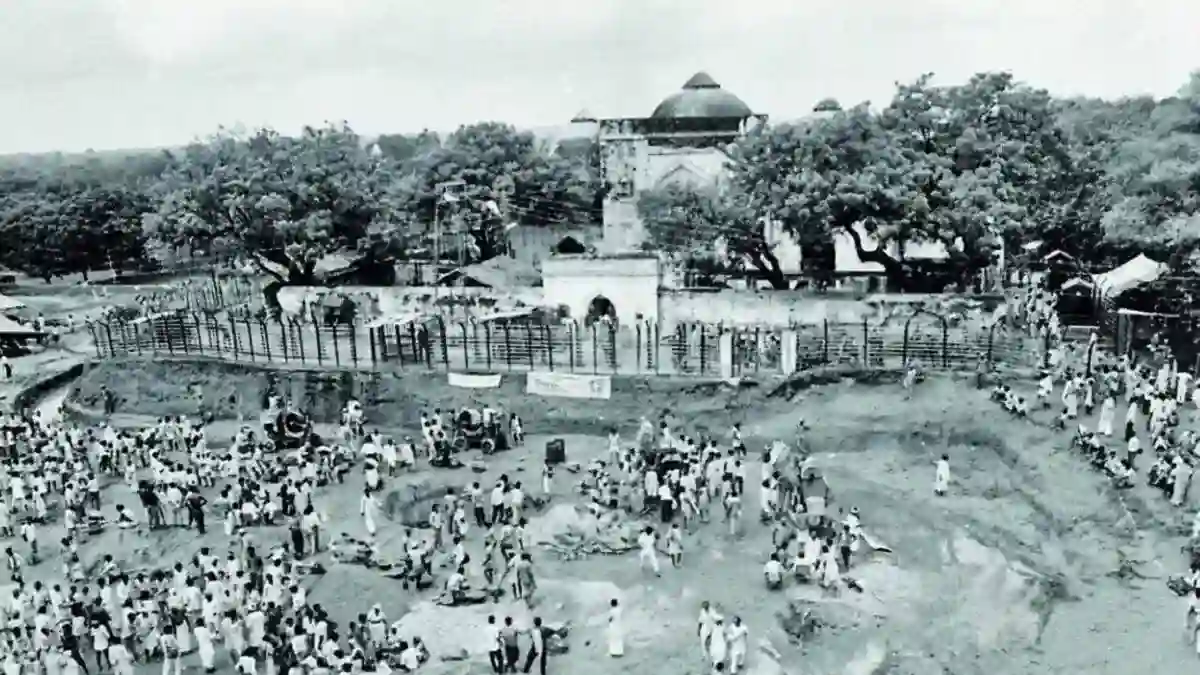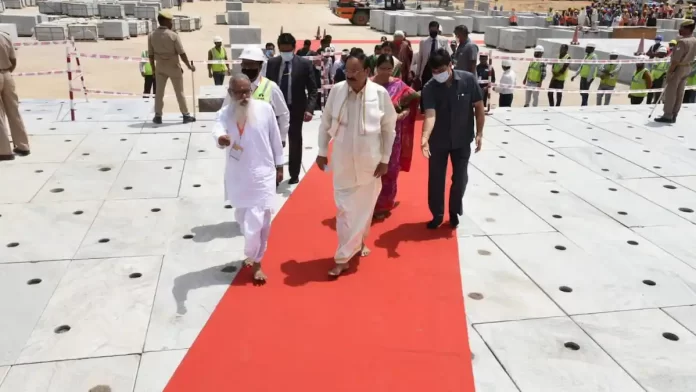Indian Vice President M. Venkaiah Naidu on Friday visited the historic Ayodhya city in Uttar Pradesh and called the reconstruction of the Ram temple a moment of spiritual renaissance in India.
He also said that the Ram Temple will continue to inspire the coming generations to respect our rich cultural heritage and show them the path of truth, justice, and brotherhood.
Showering praise on Prime Minister Narendra Modi for laying the foundation stone on August 5, 2020, he expressed happiness that the reconstruction work of the Ram temple is proceeding apace at the Ram Janma Bhoomi site.
The Vice President also praised Shri Ram Janmabhoomi Teertha Kshetra Trust set up by the Government of India for the planning and construction work of the Grand Shri Ram Mandir.
“It was gladdening to know that experts from various institutions including IITs, Central Building Research Institute, L&T Constructions, and Tata Consultancy Engineering Limited are working together as a large team overseeing this historic mission”, he said.
Economic Significance of the Ram Temple
Talking about the economic impact of the upcoming Ram temple, he said that “the reconstruction of Shri Rama Janmabhoomi temple is not simply a high point in India’s cultural history, it will also herald a new phase in the economy and development of the ancient city of Ayodhya and nearby areas”.
“Spiritual tourism is a major employment generator in India and Ayodhya, one of the most ancient cities in the world is fast emerging as a preferred destination for national as well as international devotees”, he added.
Naidu offered Prayers at the Ram Temple
Naidu who arrived in the city by a special train in the morning was welcomed by the Governor of Uttar Pradesh, Anandiben Patel, Deputy Chief Minister, Keshav Prasad Maurya, and other dignitaries at Ayodhya Railway Station.
Soon after, the Vice President and his wife visited Ram Janmabhoomi Sthal (birthplace of Ram) where the members of Ram Janmabhoomi Teerth Trust made a detailed presentation through a short film showcasing the 3-D model of the upcoming Ram temple.
Subsequently, Shri Naidu performed puja at the Garbha Griha site of the under-construction Ram Temple, and also offered prayers to the Ram Lalla.
Termed Lord Rama a Symbol of India’s Culture and Values
In the visitor’s book at Ram Janmabhoomi, he wrote that “Lord Rama is a symbol of our culture, our values, and our glorious history. The life of Maryada Purushottam has always inspired the people of India and shown them the righteous path”.
The Indian Vice President also termed the reconstruction of the grand Ram temple in Ayodhya as a moment of spiritual renaissance in India.
“I am sure that this Temple will continue to inspire the coming generations to respect our rich cultural heritage and show them the path of truth, justice, and brotherhood.”, he said.
Also Read| Ambedkar’s views on Ram: Read what Babasaheb said about Lord Ram
Overwhelmed by Powerful Emotions
In a Facebook post later, Naidu wrote that he was overwhelmed by powerful emotions as he stood at his birthplace adding that the walk along the banks of the Sarayu river evoked an extraordinarily emotional experience in him.
“I pictured several scenes from the life of Lord Shri Rama on the canvas of my mind. I felt so blessed to walk on the historic and sacred path. The riverfront has been created most aesthetically with a remarkable devotional ambiance”, he said.
Offered Prayers at Hanuman Garhi Temple
Later, Naidu and his spouse offered prayers at the famous Hanuman Garhi temple in the city. It is believed that Lord Hanuman guarded the city of Ayodhya against this place after Shri Rama’s return from Lanka.
The current structure of the Hanuman Garhi Temple in Ayodhya is said to have been constructed by King Vikramaditya and houses an idol of Bal (child) Hanuman sitting on the lap of his mother Anjani.
The Vice President and his spouse, accompanied by other dignitaries, later proceeded to the holy Sarayu river and offered prayers to the ancient river which is closely associated with Lord Rama’s life.
In the evening, Naidu and his spouse also took take part in Ganga Aarti in Varanasi.
Reconstruction of Ram Temple in Ayodhya
The site in Ayodhya where the Ram Temple is being constructed earlier housed a large and magnificent medieval period Mosque called “Babri Masjid“.
However, Hindu-Brahmanical forces claimed the mosque site to be the birthplace of their mythological king-cum-god Lord Rama.
In the 1980s the Hindu Upper caste launched an intense and provocative campaign known as the “Ram Temple Movement” to reclaim the mosque site.
Surprisingly, the movement coincided with the rise of Bahujan and Mandal politics in north India which saw Hindu-Upper-caste governments getting replaced by Bahujan parties.
Nevertheless, the Ram Temple Movement culminated in the demolition and martyrdom of the historic Babri Masjid on 6 December 1992. The unfortunate event saw large-scale-communal riots, killings, and massacres all over India.

Worse, the demolition of the temple also saw the gradual downfall of Bahujan political parties and the rise of upper-caste Hindu-Brahmanical power centers all over India.
Also Read: What are Bahujan, Mandal, and Kamandal Politics in India?
After a lengthy legal battle, the Indian Supreme Court also decided in the favour of Ram Temple in 2019 by controversially holding that the disputed site was the birthplace of Ram.
Subsequently, the Indian government (led by Hindu-Brahmanical forces) set up a trust called “Shri Ram Janmabhoomi Teertha Kshetra Trust” to oversee the planning and construction of the Grand Ram Temple on a 70-acre campus.
Role of Indian Government Ram Temple Construction
The Indian government has invested heavily in the reconstruction project of the Temple. Its social and political significance can be gauged by the fact Prime Minister Narendra Modi himself went for laying the foundation stone of the temple on August 5, 2020, despite the Covid-19 outbreak.
Further, the government has roped in experts from various leading institutions of India including IITs, Central Building Research Institute, L&T Constructions, and Tata Consultancy Engineering Limited who are working together as a large team overseeing this historic mission.
Stones from nearby Mirzapur district have been used as plinth stones and granite stones from southern India and famous Makrana marble from Rajasthan are being used for the main temple structure.
To increase the durability and aesthetics of the shrine, the stone interlocking technique is being used in the construction and that special attention is being given to preserving nearby heritage structures like Sita Kup and Kuber Tila in their original form.
The 70-acre campus will also house many facilities including a facilitation center for devotees, a museum, a research center, Gaushala, and a Yoga center. Four smaller temples have also been visualized on the four corners of the rectangular boundary wall.
